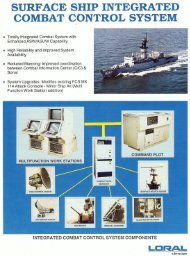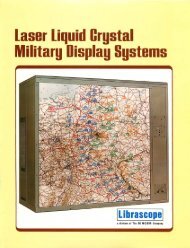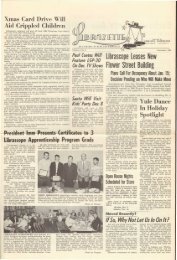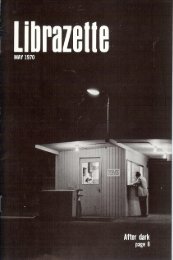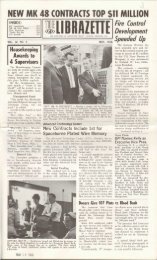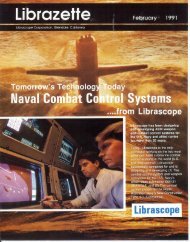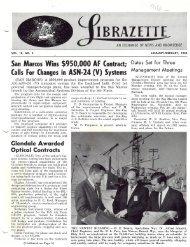Technical Review - Fall 1959. - Librascope Memories
Technical Review - Fall 1959. - Librascope Memories
Technical Review - Fall 1959. - Librascope Memories
You also want an ePaper? Increase the reach of your titles
YUMPU automatically turns print PDFs into web optimized ePapers that Google loves.
MARKET RESEARCH<br />
to keep pace with<br />
A necessity<br />
customer needs<br />
A potential buyer of graphic recording<br />
equipment stood up in his office at a<br />
West Coast rocket engine facility, looked<br />
the visiting vendor in the eye and remarked,<br />
"Show me some equipment<br />
that's brand new from the bottom up.<br />
All you have here is a re-arrangement<br />
of circuitry encased in a two-tone<br />
painted frame. It won't do our job."<br />
This is the reception greeting some of<br />
the nation's electronic sales engineers<br />
who try to "sell an old dog in new<br />
sheep's clothing."<br />
Company policy which calls for modernization<br />
of existing equipment by<br />
merely modifying circuit design and<br />
mechanical structure leaves the firm's<br />
sales force literally "carrying the ball—<br />
to the competition's goal."<br />
Naturally this approach isn't working.<br />
Sales are diminishing, with the orders<br />
going to those firms who specialize in<br />
seeking out and answering customer requirements.<br />
Positive information must<br />
be obtained about improving the capabilities<br />
of a product.<br />
Aiding the engineering, sales and production<br />
force of any electronics company<br />
are marketing specialists who<br />
maintain constant surveillance on cus-<br />
tomer needs for a particular item. Time<br />
and expense must be invested in this<br />
procedure before a prototype unit can<br />
be designed. The competition dictates<br />
this principle.<br />
<strong>Librascope</strong>, a leader in the early development<br />
of plotters and graphic recording<br />
instruments, keeps up a continual<br />
evaluation of the company's entire product<br />
line. A new X-Y Plotter is being<br />
introduced after marketing research determined<br />
that former units would be<br />
outmoded by customer requirements in<br />
the near future.<br />
Particular procedures were adhered<br />
to before the new X-Y Plotter, Model<br />
210, could be developed. An engineering<br />
team from <strong>Librascope</strong> explored the<br />
present state-of-the-art and these evaluations<br />
were studied and projected into<br />
the future plotter design. The team investigated<br />
all instruments in the plottergraphic<br />
recorder market, noting advantages<br />
and disadvantages of each.<br />
Resulting information was considered<br />
by an outside market research group<br />
composed of sales engineers familiar<br />
with X-Y Plotter user requirements. A<br />
special questionnaire, to gain information<br />
directly from operators of plotters,<br />
was distributed for determination of<br />
user requirements.<br />
It was decided that a major operational<br />
feature would be a quick, accurate scale<br />
changing technique with scale expansion<br />
possible between each step. Push button<br />
scale switching with vernier control accomplished<br />
this.<br />
This technique enables the operator to<br />
fill the entire trace area with between<br />
scale voltage inputs. The servo control<br />
loop gain was designed to be independent<br />
of the scale changes, insuring no "jump"<br />
when scales are changed.<br />
High plotting output accuracy was<br />
stressed with a static accuracy of ±.1%<br />
of full scale, and a dynamic accuracy of<br />
±.2% of full scale at 10 inches per second<br />
tracing speed. Frequency response<br />
was designed to be flat to 0 — 1 cps<br />
±.2% of full scale at 6 inches displacement<br />
amplitude.<br />
A major complaint in the questionnaires<br />
regarding earlier plotters was the<br />
difficulty in inserting paper under the plotting<br />
arm. <strong>Librascope</strong> engineers solved<br />
this problem by supplying a push-button<br />
control which automatically retracts the<br />
arm from the paper and moves it completely<br />
off the plot area. Simultaneously,<br />
input signals are locked.<br />
A vacuum platen answers the problem<br />
of keeping the graph paper in place<br />
with positive hold down characteristics.<br />
The exterior configuration and accessibility<br />
of plotter operation was a main<br />
point of consideration and <strong>Librascope</strong><br />
engineers sought outside counsel from a<br />
top industrial designer. The result was<br />
a frame which met user requirements<br />
from such standpoints as human engineering<br />
and operational convenience.<br />
Latest state-of-the-art advances are<br />
incorporated in the <strong>Librascope</strong> X-Y<br />
Plotter, Model 210 — new from the<br />
ground up.<br />
QUESTIONN.<br />
NAME<br />
ADDRESS .<br />
POSITION<br />
COMPANY ADDRESS<br />
WHAT IS V~




